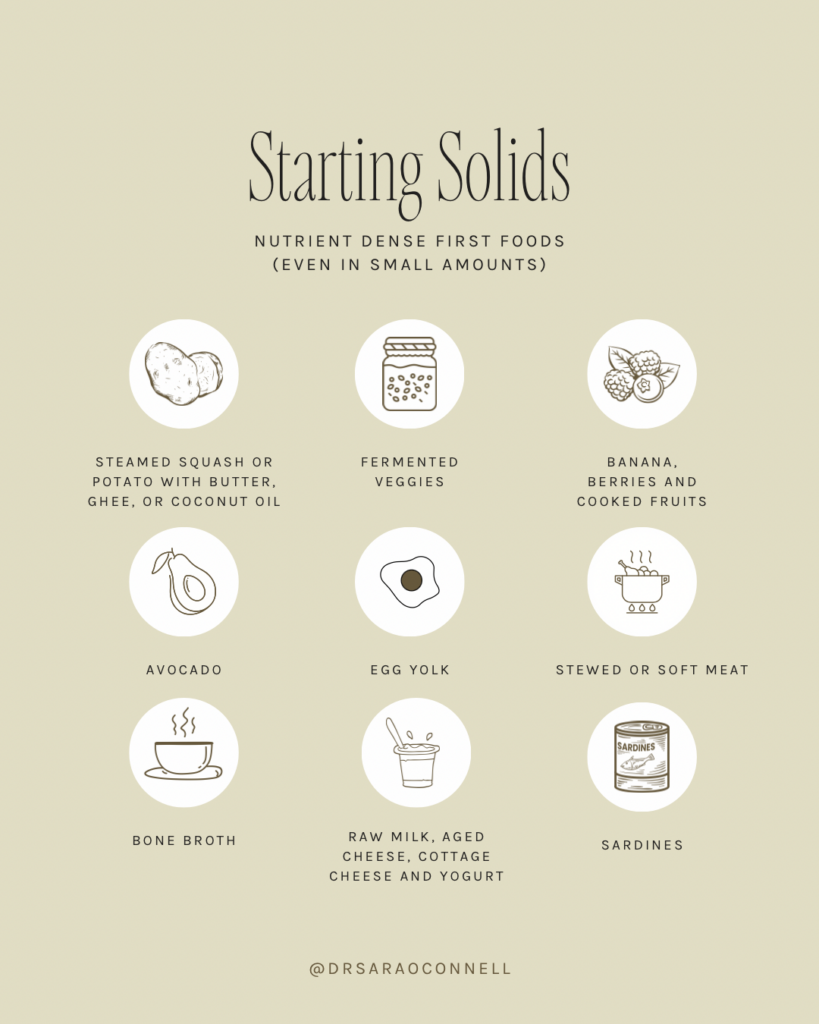Starting solids can be a really fun and exciting time for families, but navigating its ins and outs: when to start, what to start with, how to stay safe, etc., can be downright daunting.
This guide is designed to empower you when it comes to starting solids, answer frequently asked questions, and provide you with nutrient dense ideas for your baby’s first foods.
So let’s jump in!
When is my baby ready to begin solids?
The general rule of thumb is: once baby is at least 6 months old, and able to complete the following 2 milestones:
- Able to sit up on their own
- Able to grab food placed in front of them, and bring it to their mouth
Once baby is ready to begin solids, it’s best to serve foods in a form that they would normally be enjoyed in.
Infant led feeding is my favorite method for this. Here are 4 important safety rules for infant led feeding.
4 Safety Rules for Infant Led Feeding:
- Don’t help baby pick up their food
- Don’t help baby put food into their mouth
- Allowing baby to do these things on their own is essential in helping them actively prepare for swallowing.
- Sit baby upright on a sturdy surface, that isn’t your lap
- Offer solids AFTER milk, when first starting out, so baby is NOT too hungry
These rules prepare baby for the most success and help mitigate choking.
Another note on safety,
I highly recommend that all parents and caregivers, regardless of how you’re feeding your baby, take an infant CPR and choking class. These skills are life saving, inexpensive, and can even be completed online.
I’m also a fan of the LifeVac choking rescue device. I hope we never have to use it, but we have one in our house, office, and both our cars, just in case.
Examples of Foods that are Naturally Soft, Mashed, or Blended:
- Apple sauce
- Mashed potatoes
- Butternut squash
- Yogurt
- Guacamole
- Hummus
- Smoothies
- my favorite way for infants to eat nutrient dense greens
Please note:
If your baby is a slow grower, my first recommendation would be to add in more milk, rather than more food, because milk is typically higher in calories.
Calories in 4oz. of butternut squash: 32
Calories in 4 oz. of breastmilk: 79
Since new eaters are still establishing gut health, focus on offering foods that are:
- Nutrient dense
- Fiber rich
- Fermented
- Vegetables
- Bone broths
Limit known inflammatory foods (sugar, dairy, gluten, soy, etc.)
How often should I offer solid food?
- For babies 6-8months old, offer food at least 1x/day
- For babies 9-10months old, offer food at least 2x/day
- For babies 11-12months old+, offer food at least 3x/day
Nutrients to Focus On:
- Iron
- meats, legumes, nut butters, greens
- pair foods with vitamin C to increase absorption
- Vitamin D
- breastmilk is not deficient in vitamin D unless mom is deficient in vitamin D
- make sure mom is supplementing if she’s deficient
- Calcium
- greens, kale, seaweed, white beans, black eyed peas
A note on allergies,
Allergies: it’s important to know the signs of food allergies, however it is not necessary to introduce just 1 food at a time unless your baby is/has shown signs of allergies.
If you are breastfeeding or breastfed and did not see signs of allergies in baby when you ate certain foods, that’s a good sign.
Top 12 Infant/Toddler Food Sensitivities and Allergies:
- Dairy
- Gluten
- Eggs
- Soy
- Corn
- Oats
- Rice
- Peanuts
- Tree nuts
- Legumes
- Chicken
- Beef
This does NOT mean you need to avoid these foods.
In fact, research shows that the sooner babies try these foods, typically the less sensitive they are and will be to them for life.
First Foods that are Highly Nutrient Dense Even in Small Amounts:
Especially in the beginning, solid food for your baby may be more about them exploring and less about them actually eating. This is completely normal and natural.
Here are some first food options that are highly nutrient dense, even if they only actually swallow a very small amount.
- Steamed squash or potato with butter, ghee, or coconut oil
- Fermented veggies
- Banana, berries and cooked fruits
- Avocado
- Egg yolk
- Stewed or blended meats
- Bone broth
- Raw milk, aged cheese, cottage cheese and yogurt
- Sardines

Additional 6-8 Months Old Food Suggestions
During this age, IRON is especially important for babies. The following suggestions are listed in order from most IRON rich (BEST) to least.
That doesn’t mean you need to avoid the foods at the end of the list, they are still great options too, but the foods near the top are higher in iron.
listed in order from most IRON rich (best) to least:
- Swiss chard
- Dandelion greens
- Leeks
- Apricots
- Kale
- Pumpkin seeds
- Spinach
- Broccoli
- Pumpkin
- Peas
- Figs
- Green beans
- Blueberries
- Banana
- Raspberries
- Blackberries
- Applesauce
Additional 9-12 Months Old Food Suggestions
During this age, ZINC is especially important for babies. The following suggestions are listed in order from most Zinc rich (BEST) to least. That doesn’t mean you need to avoid the foods at the end of the list, they are still great options too, but the foods near the top are higher in zinc.
listed in order from most ZINC rich (best) to least:
- Lima beans
- Potatoes (yam, sweet, Yukon gold)
- Kidney beans
- Leeks
- Quinoa
- Peaches
- Grapes
- Carrots
- Cauliflower
- Papaya
- Pears
- Cherries
- Squash
- Cabbage
- Pineapple
And there you have it!
I hope this guide serves you and your family well as you navigate your journey into solids.
Please know that this content is for informational and educational purposes only. It is not intended to provide or replace any individual medical advice and/or treatment from your, or your kiddos, personal physician. Please consult your doctor and/or qualified pediatric practitioner for individual or specific questions and concerns.
Be well,

maternity / birth / motherhood
reach out
Investment
About Sara
Blog
I'm so excited to connect with you for your maternity, birth and newborn photography!
Based in the Teton Valley, I happily serve Jackson Wyoming, Rexburg Idaho and everywhere in between. Let's capture your story together.
